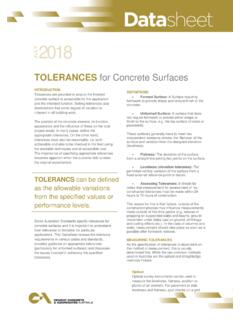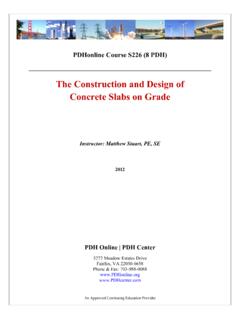Transcription of Checklist for the Concrete Pre-Construction Conference
1 Checklist for the Concrete Pre-Construction Conference Introduction Pre-Construction meetings are of prime importance in planning Concrete construction work because many potential problems can be avoided at the right time before the start of the project when the cost impact is relatively low. In 1999, the National Ready Mixed Concrete Association (NRMCA) and the American Society of Concrete Contractors (ASCC) joined in a partnership to enhance the quality of Concrete construction. This Checklist is one of the ongoing initiatives of the partnership. NRMCA and ASCC recognize the benefits resulting from participating in these Pre-Construction meetings and have prepared this Checklist for the Concrete Pre-Construction Conference to assist the decision makers and participants on a project - representing the owner, specifier, general contractor, Concrete contractor, Concrete producer, other material suppliers and testing agency in planning quality Concrete construction work.
2 The Checklist allocates responsibilities and establishes procedures related to Concrete construction subgrade preparation, forming, Concrete mixture proportioning (mix design), necessary equipment, ordering and scheduling materials and operations, placing, consolidating, finishing, jointing, curing and protection, testing and acceptance as well safety and environmental issues. The Checklist covers some of the issues that need to be discussed at a Pre-Construction meeting and is not intended to be all-inclusive. NRMCA/ASCC Concrete Pre-Construction Checklist Page 1 of 18. Sample Checklist for the Concrete Pre-Construction Conference A. Project Information 1. Project name 2. Location 3. Project start date 4. Project completion date 5. Project participants Contact Owner Architect Structural engineer Construction manager or General contractor Concrete contractor Concrete producer Admixture supplier Concrete pumping contractor Concrete finisher testing laboratory Inspection agency Other 6.
3 Background information about the project 7. Unique features of the project 8. Distribution of completed Checklist Project Participants Others: NRMCA/ASCC Concrete Pre-Construction Checklist Page 2 of 18. B. Construction Process 1. Review notes and changes on drawings that may affect construction process 2. Sequence of construction and milestones dates a. Foundations b. Walls c. Structural slabs d. Slab-on-grade interior e. Slab-on-grade exterior 3. Construction/Acceptance of base/subgrade, compaction, elevation. Responsibility for: a. Providing base and subgrade elevations to contractors b. Stability of the base and or subgrade under construction traffic c. Protecting the base and/or subgrade from water damage d. Compacting and final grading of the base and subgrade after all plumbing installations are complete e. Location of electrical lines (conduit). In subgrade trenched and backfilled with rock In rock subgrade Protection from truck traffic if required 4.
4 Responsibility for site access roads and their maintenance 5. Responsibility for available space for pumping operations if required Access for two trucks to pump, one on each side Staging area for testing and slump adjustment 6. Person responsible for directing trucks to pump or placement area 7. Responsibility for directing/backing up trucks 8. Responsibility for power, lighting, water, and water pressure during placing and finishing 9. Responsibility for controlling the ambient temperatures (subgrade, forms, and air). NRMCA/ASCC Concrete Pre-Construction Checklist Page 3 of 18. 10. Forms a. Form sizes, types b. Lifting equipment required c. Form materials, accessories d. Review location of reinforcement, embedded items, waterstops, drains, openings, openings for frames, etc. e. Scheduling form erection and removal correlated to reinforcing and concreting operations f. Responsibility for installation and inspection i. Reinforcement ii.
5 Embedded items iii. Waterstops iv. Drains v. Opening Frames g. Responsibility for form inspections i. Preliminary prior to rebar placement ii. Semifinal with rebars, embedded items, waterstops and drains: Note: Reinforcement inspection must include Location and spacing to allow access for vibration equipment and proper coverage Spacing of reinforcement in relation to aggregate size iii. Final before placing Concrete 11. Vapor retarder or vapor barrier membrane a. Type of membrane b. Location of membrane relative to subgrade c. Effect on curling d. Effect on bonding of applied floor coverings e. Basis of acceptance for installation of moisture sensitive flooring materials (wood, carpet, tiles) on the slab i. Moisture emission requirements for flooring materials to be installed ii. Responsibility for testing and reporting of the test results Acceptance of the slab 12. Placing Concrete : equipment and procedures a. Deposit from truck b.
6 Buggy c. Belt conveyor d. Bucket placement NRMCA/ASCC Concrete Pre-Construction Checklist Page 4 of 18. e. Pumping f. Other 13. Consolidation of Concrete : equipment and procedures a. Vibrators b. Vibratory screeds (surface vibrators). c. Back up equipment d. Power source e. Other 14. Responsibility for inspection of placing and consolidation of Concrete 15. Ventilation in enclosed spaces a. Type of test required b. Responsibility for ventilation: i. During placement ii. During finishing 16. Strike off technique Hand strike off Vibratory screed Laser screed Other 17. Finishing a. Types of finishes Area 1. Area 2. Area 3. Area 4. b. Special materials for finishes Dry-shake hardener Rate of application Procedure to install c. Tools and equipment required d. Back up tools and equipment required NRMCA/ASCC Concrete Pre-Construction Checklist Page 5 of 18. 18. Specified tolerances for a. Vertical Concrete surfaces: Plumbness Dimensions Thickness Texture Color Acceptable variances Surface defects Others Note.
7 Refer to ASCC Guide for Surface Finish of Formed Concrete b. Slabs-on-grade and floors flatness / levelness Dimensions Thickness How it will be determined Texture Color Acceptable variances Surface defects Joint spacing Others c. Elevated slabs flatness / levelness Dimensions Thickness How it will be determined Texture Color Acceptable variances Surface defects Others d. Procedures for measuring tolerances (when and how). e. Review specifications for possible conflict between the Concrete installer and other trades NRMCA/ASCC Concrete Pre-Construction Checklist Page 6 of 18. f. Review specifications for conflict between the surface profile provided by the Concrete installer and the surface profile required by installer of finish material g. Responsibility for i. Reporting F-numbers to Concrete contractor ii. Accepting floors iii. Measuring tolerances iv. Repairing air or bug holes in vertical surfaces v. Removing curing compounds prior to application of sealers 19.
8 Jointing a. Review/verification of contraction, isolation, expansion, and construction joint layout plans Structures (walls) Yes No Comments (number, location, spacing, details). Slabs-on-grade Yes No Comments (number, location, spacing, details). b. Type of joints contraction isolation expansion 1. Formed joints 2. Tooled joints 3. Early entry saw-cut Timing Depth of cut Joint spacing Equipment 4. Conventional saw-cut Timing Depth of cut Joint spacing Equipment c. Slabs-on-grade i. Joints Yes No ii. Reinforcement Yes No Position of reinforcement in slab Method of supporting reinforcement at specified elevation Termination at joints NRMCA/ASCC Concrete Pre-Construction Checklist Page 7 of 18. iii. Load transfer devices ( dowel bars). Type, size, and location Check for specified alignment iv. Define unacceptable cracks (see surface defects in tolerances). v. Method of repair of unacceptable cracks vi. Responsibility for repair of unacceptable cracks vii.
9 Sealing (Filling) Joints Yes No Epoxy joint filler Yes No Elastomeric sealant Yes No Timing (review product directions and ACI Guidelines). Depth of filling Procedure (flush or a slightly crowned for epoxy joint or concave for elastomeric sealant). Responsibility for future touch up 20. Curing and Sealing a. Curing methods b. Curing periods c. Responsibility for curing floors placed prior to erection of roof, walls d. Temperature Control Yes No Specify If temporary heaters are used, responsibility for venting to prevent Concrete dusting e. Excessive evaporation control Specify f. Evaporation retarder Yes No Specify g. Fogging Yes No Specify h. Other i. Responsibility for inspection of curing operations/timing j. Responsibility for removing curing compounds k. Applying sealers Types Locations NRMCA/ASCC Concrete Pre-Construction Checklist Page 8 of 18. 21. Protection of Concrete a. Roof and Walls Yes No Specify b. Floors coverings Yes No Specify c.
10 floor Protection Yes No i. Specify age/strength of floor prior to the use of floor by: Foot traffic Pneumatic tire traffic Hard wheel traffic Construction traffic ii. Specify age/strength of floor when Equipment is installed Racks are erected 22. Responsibility for storage areas and site security 23. Form removal a. What is the minimum strength requirement for form removal? psi. b. What formal report is required before form removal? c. Type of field or in-place strength tests if used and evaluation criteria? d. Name(s) of personnel authorized to approve form removal 24. Procedures for hot weather concreting 25. Procedures for cold weather concreting NRMCA/ASCC Concrete Pre-Construction Checklist Page 9 of 18. C. Concrete Materials and Required Mixture Proportioning (Mix Design). 1. Concrete Mixtures (Mix Design). List of Mixture (Mix Mixture (Mix Design) Location Approximate Volumes Design) Designations Codes 2. Mixtures (Mix designs) acceptance a.





